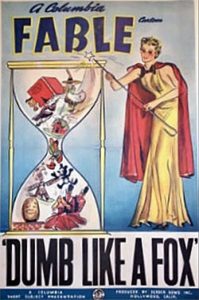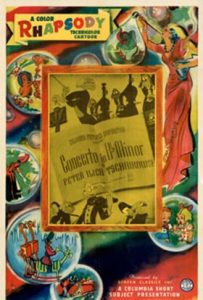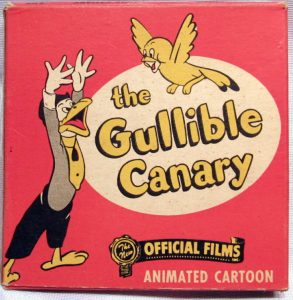Columbia’s Musical “Gems” 1941-43

 By the time we were well and truly involved in WWII, Columbia’s cartoon division had well and truly recovered from the departure of Charles Mintz. Most of the old hands were still there, and had been joined by two veterans of the business whose approaches you would think would be diametrically opposed. On the one hand, Frank Tashlin, and on the other, Dave Fleischer. While there may not have been much overlap between their respective work, one would suspect getting used to Tashlin’s style would have resulted in quite a shift in direction when Fleischer cane on the scene. Exhibitors must nevertheless have liked the sound of hearty laughter that they would have heard from some of the best of these cartoons. Columbia further acquired during this period what would be their prime character asset through the 1940’s – Fox and Crow, the creations of Tashlin, who remained in solid hands after Tashlin’s departure under the able direction of Bob Wickersham.
By the time we were well and truly involved in WWII, Columbia’s cartoon division had well and truly recovered from the departure of Charles Mintz. Most of the old hands were still there, and had been joined by two veterans of the business whose approaches you would think would be diametrically opposed. On the one hand, Frank Tashlin, and on the other, Dave Fleischer. While there may not have been much overlap between their respective work, one would suspect getting used to Tashlin’s style would have resulted in quite a shift in direction when Fleischer cane on the scene. Exhibitors must nevertheless have liked the sound of hearty laughter that they would have heard from some of the best of these cartoons. Columbia further acquired during this period what would be their prime character asset through the 1940’s – Fox and Crow, the creations of Tashlin, who remained in solid hands after Tashlin’s departure under the able direction of Bob Wickersham.
Dumb Like A Fox (7/18/41) – A hunting dog’s pup wants to get into fox hunting like his old man, but Dad doesn’t think the boy is ready. Nevertheless, the pup meets up with a fox, who plays mind games with him, finally getting him to capture and bring back to pop a skunk. The film seems to anticipate the kind of species mix-up that became commonplace for Foghorn Leghorn’s schemes with Henery Hawk. Steve Stanchfield (and Jerry Beck) think this is one of the worst Columbia cartoons ever made. Song: “I’m a Hunting Dog”, an original lyric set to the melody of “A Hunting We Will Go”.
The Merry Mouse Café (8/15/41) – It’s past closing time at a swanky night club. The mice are making merry. A Jimmy Durante-styled mouse, acting as master of ceremonies, brings on Hedy LaMouse, a night club songstress. The host also has to deal with a relative from the country, who is in the city to see the sights. He (Elmer) winds up dancing with Hedy, and the two seem to be hitting it off quite well, which surprises the host. A janitor come along and everybody skedaddles. It’s a raid! The host notices Hedy running off with Elmer in tow, and when he asks her about it, she has the last word. “He may be corny, but he sure can make hey-hey.” Song: An original conga number, presumably written by Eddie Kilfeather. Kilfeather had been second piano with George Olsen and His Music during the late 1920’s.
 Concerto In B Flat Minor (3/20/42) – As the Second Hungarian Rhapsody had already been taken, Tashlin tries his hand with another classic that had recently become familiar with the public. The main melody of the first movement of the Concerto in B Flat Minor by Peter Ilyich Tchaikovsky had become popular in modern music thanks to Freddy Martin playing a dance arrangement, which Martin could play on broadcasts that year, as ir was not an ASCAP song. A lyric was written soon afterwards, and the song became known as “Tonight We Love.” Gags come from various members of the orchestra doing things that you wouldn’t expect from members of a symphony. Eating peanuts on stage. Having their fingers do spasmodic movements after playing a passage on a harp. And a piccolo player who refuses to shut up. There are also many gags built around the conductor, a Stowkowski type but with a baton. Victor piu out a good-selling album set of the piece by Arturo Toscanini and the NBC Symphony Orchestra, with Vladimir Horowitz as soloist. An Oscar Levant version followed on Columbia Masterworks in the mid-1940’s. Columbia in England issued an early version by Sir Hamilton Harty and the Halle Orchestra, and later version by Sir Thomas Beecham and the London Philharmonic Orchestra. Another late popular version was by Van Cliburn, a young man from Cut and Shoot, Texas who somehow went to Russia, and somehow won a Tchaikovsky competition playing the piece. He returned to the United States with something of a hero’s welcome, and recorded the Concerto for RCA Victor, in one of their first Living Stereo offerings. The Freddy Martin popular version was on Bluebird, first as “Piano Concerto In B Flat”, then with vocal as “Tonight We Love”. Tony Martin covered the vocal version for Decca. Xavier Cugat gave the vocal a Latin touch on Columbia. Joe Reichman’s Orchestra got it for Victor. Jack Fina (Freddy Martin’s pianist) went solo in the mid-40’s and recorded it again for Mercury.
Concerto In B Flat Minor (3/20/42) – As the Second Hungarian Rhapsody had already been taken, Tashlin tries his hand with another classic that had recently become familiar with the public. The main melody of the first movement of the Concerto in B Flat Minor by Peter Ilyich Tchaikovsky had become popular in modern music thanks to Freddy Martin playing a dance arrangement, which Martin could play on broadcasts that year, as ir was not an ASCAP song. A lyric was written soon afterwards, and the song became known as “Tonight We Love.” Gags come from various members of the orchestra doing things that you wouldn’t expect from members of a symphony. Eating peanuts on stage. Having their fingers do spasmodic movements after playing a passage on a harp. And a piccolo player who refuses to shut up. There are also many gags built around the conductor, a Stowkowski type but with a baton. Victor piu out a good-selling album set of the piece by Arturo Toscanini and the NBC Symphony Orchestra, with Vladimir Horowitz as soloist. An Oscar Levant version followed on Columbia Masterworks in the mid-1940’s. Columbia in England issued an early version by Sir Hamilton Harty and the Halle Orchestra, and later version by Sir Thomas Beecham and the London Philharmonic Orchestra. Another late popular version was by Van Cliburn, a young man from Cut and Shoot, Texas who somehow went to Russia, and somehow won a Tchaikovsky competition playing the piece. He returned to the United States with something of a hero’s welcome, and recorded the Concerto for RCA Victor, in one of their first Living Stereo offerings. The Freddy Martin popular version was on Bluebird, first as “Piano Concerto In B Flat”, then with vocal as “Tonight We Love”. Tony Martin covered the vocal version for Decca. Xavier Cugat gave the vocal a Latin touch on Columbia. Joe Reichman’s Orchestra got it for Victor. Jack Fina (Freddy Martin’s pianist) went solo in the mid-40’s and recorded it again for Mercury.
Woodman, Spare That Tree (7/2/42) – Fox is going to his daily job of cutting down trees. His aim is to chop down the old oak tree, singing all the way. As the Crow resides in that tree, he doesn’t want to see it cut down. Fox winds up doing his best impression of Wile E. Coyote, as all his attempts to cut the tree lead to at least minor disasters. Fox’s attempts get more and more elaborate, leading to enlisting an elephant to attempt to shove the tree down. Crow consults his ency-crow-pedia to figure out how to counter this pachyderm peril. A toy mouse does the trick, and another failure for Fox. This leads Fox to construct a railroad track and locomotive to attack the tree. Crow breaks the fourth wall, letting the audience know they are about to see the worst train wreck since the Wreck of the Old 97, revealing a page in his book reading “This tree is petrified”. A gigantic crash leaves the train a wreck – but the tree topples too. Crow flips to the last page of the book for an explanation, finding in large red letters the response, “Sucker!” Frank Graham, providing the voices of both characters, performs a nice bit of track looping to have the characters duet on a few bars of “Home Sweet Home”. A further song classic is “Artist’s Life”, the classic Strauss waltz, performed by Fox with lyric about chopping the old oak tree. Recordings abound and are too numerous to mention, some principal ones including the Zon-o-Phone Concert Band (one of the earliest), the Vienna Philharmonic on Victor red seal. The Boston Pops on Victor Red Seal, Andre Kostelanatz on Columbia Masterworks, and Al Goodman on Columbia in a dance band style.
 The Gullible Canary (9/18/42) – A hobo hawk (bindle stick and all) is complaining about the expectations of being a bird (going South for the winter, North for the summer, yah-ta yah-ta). The hawk sees the life of a canary in a small cage, getting food, drink, and comfortable furnishings without having to fly. So, the hawk pulls a fast one, convincing the canary to go out and see the world. The canary does fall for the line, while the hawk takes over his comfortable cage and adds quite a bit of wear and tear to the furniture in a careless manner. The canary meanwhile faces all the dangers of a life in the wild – pursued by cat, larger predator bird, lost in a snowstorm, but finally having a ray of hope come his way, landing atop the snow-covered roof of a train bound for Florida. When spring comes again, the hobo hawk has an unexpected pair of visitors – the returned canary, and his new Missus – a Southern Belle canary of huge dimensions (possibly inspired by Kate Smith), but all muscle. They announce that they will take up residence – right here – and the Missus resorts to powerful blows to drive the interloper back to the road. Song: “Hallelujah, I’m a Bum”, written and performed on record by Harry (Haywire Mac) McClintock on Victor. McClintock was a genuine hobo, who happened to catch Victor’s attention from his proximity to a pressing plant of the company in Oakland. The melody is lifted from a hymn, “Revive Us Again”, which may itself have lifted melody from an 1813 operetta. “The Miller and His Men”. The song was covered by Ernest Hare (as “Hobo” Jack Turner_ on Velvet Tone, Harmony, and Diva. Vernon Dalgart issued a Columbia version (below). An unknown named George Anthony appeared on Gray Gull and Madison. Another unidentified singer, billed as “Weary Willie”, appeared on Perfect. Frank Luther got it for Brunswick. “Lazy” Larry (possible Carson Robison, Luther’s usual partner) recorded his own version on Romeo. Robison would visit England with his “Pioneers” a few years later, and include the number on a two-sided Medley entitled “Hill Billy Songs” for English Columbia. The song should not be confused with a later number by the same name, penned for Al Joson in a picture for United Artists that lifted its title from the McClintock song, and likely never paid a royalty to him.
The Gullible Canary (9/18/42) – A hobo hawk (bindle stick and all) is complaining about the expectations of being a bird (going South for the winter, North for the summer, yah-ta yah-ta). The hawk sees the life of a canary in a small cage, getting food, drink, and comfortable furnishings without having to fly. So, the hawk pulls a fast one, convincing the canary to go out and see the world. The canary does fall for the line, while the hawk takes over his comfortable cage and adds quite a bit of wear and tear to the furniture in a careless manner. The canary meanwhile faces all the dangers of a life in the wild – pursued by cat, larger predator bird, lost in a snowstorm, but finally having a ray of hope come his way, landing atop the snow-covered roof of a train bound for Florida. When spring comes again, the hobo hawk has an unexpected pair of visitors – the returned canary, and his new Missus – a Southern Belle canary of huge dimensions (possibly inspired by Kate Smith), but all muscle. They announce that they will take up residence – right here – and the Missus resorts to powerful blows to drive the interloper back to the road. Song: “Hallelujah, I’m a Bum”, written and performed on record by Harry (Haywire Mac) McClintock on Victor. McClintock was a genuine hobo, who happened to catch Victor’s attention from his proximity to a pressing plant of the company in Oakland. The melody is lifted from a hymn, “Revive Us Again”, which may itself have lifted melody from an 1813 operetta. “The Miller and His Men”. The song was covered by Ernest Hare (as “Hobo” Jack Turner_ on Velvet Tone, Harmony, and Diva. Vernon Dalgart issued a Columbia version (below). An unknown named George Anthony appeared on Gray Gull and Madison. Another unidentified singer, billed as “Weary Willie”, appeared on Perfect. Frank Luther got it for Brunswick. “Lazy” Larry (possible Carson Robison, Luther’s usual partner) recorded his own version on Romeo. Robison would visit England with his “Pioneers” a few years later, and include the number on a two-sided Medley entitled “Hill Billy Songs” for English Columbia. The song should not be confused with a later number by the same name, penned for Al Joson in a picture for United Artists that lifted its title from the McClintock song, and likely never paid a royalty to him.
 Tito’s Guitar (10/30/42) – The title of this film was undoubtedly inspired by the name of a popular Mexican singer, Tito Guizar. In fact, by this time, a famous radio blooper might have already occurred, where an announcer introduced a number as by “Tito Guitar and his Guizar”. Here, Tito is a little Mexican boy riding a burrito, and heading for a hacienda to do some serenading of his fair lady on his guitar – which gets papa all riled up. Song: “La Rosita”, a song actually written in Paris by a M. Dupond, as a tango. The International Novelty Orchestra directed by Eduardo Migil y Robles issued an acoustic Victor in 1923. Two early electricals are by Eddie South and his Alabamans on Victor in 1928, and by Gus Arnheim and his Cocoanut Grove Orchestra on Victor, done in popular concert style. A Brunswick house band, under direction of Louis Katzman, appeared as “The Floridians”. Sol K. White’s Hollywians issued an island-flavored version on Victor in 1934. Orrin Tucker issued a Columbia with vocal group “The Bodyguards”. Benny Goodman issued a good-sounding Columbia, with arrangement by Eddie Sauter. Jimmy Dorsey appeared on Decca (below). Xavier Cugat issued a Victor side. Les Paul issued a typical well-engineered multitrack instrumental on Capitol. A Tex Beneke version would appear (I am unsure if from Victor or from transcription). Joe Green’s Marimba Band would record a very late side for Continental. The Four Aces would perform a vocal for Decca in the 1950’s. Stanley Black issued a stereo album cut for English Decca. Coleman Hawkins and Ben Webster also issued a stereo jazz version for LP on Verve. Alfred Hause’s orchestra also issued an LP version on unknown label.
Tito’s Guitar (10/30/42) – The title of this film was undoubtedly inspired by the name of a popular Mexican singer, Tito Guizar. In fact, by this time, a famous radio blooper might have already occurred, where an announcer introduced a number as by “Tito Guitar and his Guizar”. Here, Tito is a little Mexican boy riding a burrito, and heading for a hacienda to do some serenading of his fair lady on his guitar – which gets papa all riled up. Song: “La Rosita”, a song actually written in Paris by a M. Dupond, as a tango. The International Novelty Orchestra directed by Eduardo Migil y Robles issued an acoustic Victor in 1923. Two early electricals are by Eddie South and his Alabamans on Victor in 1928, and by Gus Arnheim and his Cocoanut Grove Orchestra on Victor, done in popular concert style. A Brunswick house band, under direction of Louis Katzman, appeared as “The Floridians”. Sol K. White’s Hollywians issued an island-flavored version on Victor in 1934. Orrin Tucker issued a Columbia with vocal group “The Bodyguards”. Benny Goodman issued a good-sounding Columbia, with arrangement by Eddie Sauter. Jimmy Dorsey appeared on Decca (below). Xavier Cugat issued a Victor side. Les Paul issued a typical well-engineered multitrack instrumental on Capitol. A Tex Beneke version would appear (I am unsure if from Victor or from transcription). Joe Green’s Marimba Band would record a very late side for Continental. The Four Aces would perform a vocal for Decca in the 1950’s. Stanley Black issued a stereo album cut for English Decca. Coleman Hawkins and Ben Webster also issued a stereo jazz version for LP on Verve. Alfred Hause’s orchestra also issued an LP version on unknown label.
He Can’t Make It Stick (7/11/43) – Plot description for this one can only be incomplete, due to half of the original film being missing from surviving picture element and seemingly lost to time. Hitler is portrayed as a paper hanger, with family of characters representing Germans, and trying to get his new swastika pattern paper covering the world. Of course, it loosens and blows off of everywhere it touches, finally settling in a pig pen.Song: “Du. Du Liegst Mir Im Herzen (You, You in My Heart)” An old song circa 1820, used as a marker for things German. Columbia had an early version in the large note label design by Aida De Marion and Karl Jorn. Alma Gluck and Paul Reimers had an acoustic notable on red seal Victor. An electrical remake would replace it in the catalog, still featuring Reimers, but substituting Hulda Lashanska for Gluck’s part. An Amsterdam recording appeared in European Columbia catalog in the 30’s by Jo Vincent and Louis Van Tulder. An Ultraphon issue much later featured Lotte Leonard and Hermann Schey. An English lyric was finally written for the piece in the late 1940’s, as “You, You, You Are the One”, recorded by Russ Morgan and the Ames Brothers for Decca (below).
Mass Mouse Meeting (6/25/43) – A different read on Aesop’s old tale of belling the cat. A mouse who wouldn’t be much of a mouthful for the cat has to use all of his guile to get the cat to put on a jungle-bell collar – then has to think of something quick when the cat asks for the key to the collar’s lock. “It’s a combination lock”, the mouse improvises, and scatters away. The other mice plan a feast for the successful mouse, but the feast never happens as they hear jingle bells – and it sure as the deuce ain’t Santa Claus. Song: “I’ve Got My Fingers Crossed” introduced by Fats Waller in an Alice Faye musical for Fox in 1935, King of Burlesque (below). Recorded by Waller for Victor, and by Faye on Melotone, Perfect, et al. Louis Armstrong got it for Decca, while the Mound City Blue Blowers got it for Decca Champion. Louis Prima did the honors on Brunswick. Victor issued a Jan Garber version, one of his last sides before leaving for Decca.
NEXT TIME: On through ‘43 and ‘44.
